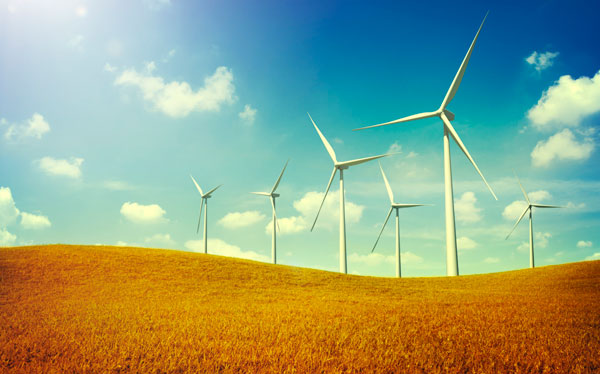
Michigan has become a top state for wind energy production. The Michigan Public Service Commission (MPSC) estimates that, as of mid-2017, the state contained more than 900 wind turbines, generating approximately 1,760 MW of power.
And because the Great Lakes have a profound effect on weather, including the generation of wind, energy from wind sources remains not only renewable but ideal for Michigan’s unique geographical layout.
To the average business executive or investor, one kilowatt-hour of electricity is just like another. To facilities managers, however, the efficiency and renewability of wind energy represent significant potential benefits to the buildings they manage and the people who occupy them.
Here’s what facilities managers need to know in order to pitch wind energy to investors and stakeholders.
The Expansion of Wind Power in Michigan
Michigan has pushed wind power for several years. A 2008 requirement for 10 percent renewable energy by 2015 kick-started the state’s interest in wind and solar options, although a 2012 ballot initiative seeking to bump these numbers to 25 percent by 2025 failed at the polls, according to Silvio Marcacci at CleanTechnica.
The push for renewable wind energy in the state also increased the value of farmland, according to Andy Balaskovitz, and in some cases farmers’ incomes, as well. Leasing land for wind turbine use has become a popular way for landholders to increase their incomes with minimal effort, according to Nicole Hayden in the Port Huron Times-Herald.
Currently, the bulk of Michigan’s wind energy developments are located in the thumb, according to the MPSC. Nevertheless, discussion of moving wind turbines offshore to take advantage of the Great Lakes’ significant wind-generating power and of placing wind energy zones on West Michigan’s coastlines continues. Large parts of Allegan County, just west of Kalamazoo and south of Grand Rapids, have been designated a Wind Energy Zone, placing renewable wind energy even closer to the heart of West Michigan.

Why Wind?: Benefits to Buildings and Large Facilities
A number of large facilities in Michigan have erected their own wind turbines in order to maximize the value of wind energy to their organizations. Kalamazoo Valley Community College, for instance, uses a wind turbine built and maintained by students that have not only helped reduce the college’s utility costs but has also become the centerpiece of the college’s wind turbine technician training program, according to reporter Kayla Miller.
Whether or not a facility chooses to dedicate resources to its own wind turbines, however, it can benefit significantly from a commitment to consuming wind energy. Here are some of the biggest benefits for buildings:
Wind Energy is Cost-Competitive
One of the biggest driving forces behind the adoption of wind energy in Michigan, and around the world, is its low cost relative to other energy sources. The federal Wind Energy Technologies Office estimates that land-based utility-scale wind turbines cost “between two and six cents per kilowatt-hour.”
Because the fuel (wind) is free and energy can be stored to make its availability more stable, “wind energy mitigates the price uncertainty that fuel costs add to traditional sources of energy.” DTE Energy senior communications specialist Cindy Hecht has called wind “the most efficient and cost-effective form of renewable energy.”
An extension of the Federal Production Tax Credit for wind in recent years, combined with lower prices for wind energy relative to fossil fuel or natural gas energy, have also driven wind’s prominence in Michigan, according to Michigan Public Service Commission manager of renewable energy Julie Baldwin. Multiple federal tax credits and state-level incentives help further reduce the cost of wind energy for facilities seeking to change their power profile.
Wind Energy Drives Local Economies, Recruiting and Retention
Wind energy investments drive not only those who use the power provided by the project, but also local economies. According to the facilities management division at Georgia Tech, wind turbine projects encourage local economic development and investment in local infrastructure and municipal services, such as fire and police protection.
In Michigan’s Huron County, treasurer and assessor Nancy Heck specifically notes that rising revenues have greatly increased local library budgets, allowing some libraries to commit to upgrades they haven’t been able to access for 40 years. Heck also notes revenue increases in the county, road commission, and school budgets. Public and municipal projects and services are essential for any business seeking to attract and retain top talent or to maintain the necessary stability to grow.
When it comes to attracting top talent, not only does a strong local economy make a company’s offering more appealing, but a commitment to wind energy does, as well. At the University of Iowa, President Bruce Herreld notes that the university’s commitment to a coal-free, renewable energy future was essential for attracting top students and faculty and retaining the faculty and staff already contributing to the university’s mission.
In an interview with the Port Huron Times-Herald, Sanilac Township farmer Dean Kritzman cited the renewable features of “clean” wind energy as one reason he leased land to energy company Exelon for the placement of a wind turbine on his property.
As local economies grow, so does the national economy. The Wind Energy Technologies Office estimates that wind energy adds about $20 billion to the US economy each year.
Energy Storage Is ‘The Next Big Thing’
In the past, the excess energy created by wind and solar generators was simply sold back to the national grid. Today, however, energy storage technology is making it more cost-effective for large facilities to invest in renewable energy technologies, according to Bill Wright, head of energy solutions at the Electrical Contractors’ Association (ECA). Wright estimates that storage systems pay for themselves in eight years or less, and calls energy storage “the next big thing” in renewable energy.

Pitching the Benefits of Wind Energy to Stakeholders: Tips for Success
Understanding the value wind energy provides is one thing; convincing building owners and business stakeholders is another. Here’s how facilities managers can make their case.
Break Down the Numbers
Research on costs related to wind energy is available from a number of sources, including the federal Wind Energy Technologies Office and the Michigan Public Service Commission. As Stanley Pruss, a senior fellow at 5 Lakes Energy, has noted, “We know precisely the amount of revenue attributed to industrial personal property taxes, specifically for wind turbines.”
In other words, the numbers are out there, making it easier for facilities managers to compare the costs of wind energy to the costs of other options — and to present these numbers to stakeholders.
Go Long-Term
Wind energy provides a number of immediate or short-term benefits, including cost reductions and certain tax benefits. But a long-term return on investment is also important to building owners or business stakeholders seeking to build a sustainable project. Skanska recommends its facilities managers address long-term impacts in areas such as:
- Economics. How will wind energy help stakeholders meet cost targets? How will a renewable energy project, like a wind turbine, help the company recover costs over time?
- Security. Fluctuations in global markets for coal, natural gas and other energy sources are affected by political, geographic, and climate concerns as well as the ever-rising demand for an ever-decreasing supply. How will wind energy help stakeholders in this building or business protect their investments against the vagaries of the market?
- Environment. As Skanska notes, “Saving fossil fuel energy cuts the greenhouse gas emissions associated with human operations, helps demonstrate green credentials ..., and helps to meet ISO 14001 commitments.” Are any of these on stakeholders’ to-do lists, and if so, what specific benefits does wind energy provide in these areas?
Think Outside the (Facilities) Box
Facilities managers understand buildings, environments and their demands. To most building owners and business stakeholders, however, the domain of facilities management is only one piece of a larger worldview.
To further convince stakeholders of the value of wind energy, be prepared to discuss the impact of renewable power options on areas outside the facility itself. For instance, add information on the effects of a commitment to renewables on employment branding, recruitment and retention, or community goodwill to the discussion. Expertise in these areas isn’t necessary: Even a few facts and statistics on the human element of renewables and their effect on business can help bolster a facilities-focused case on the value of wind energy.
Credits:
rawpixelphartisan
andreypopov
